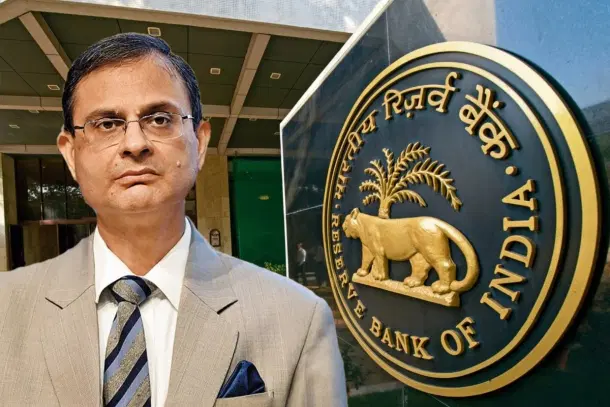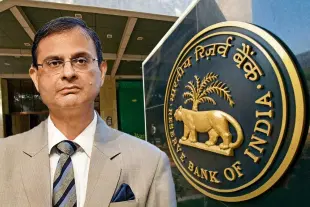Economy
For Too Long, RBI Hasn't Rewarded Government's Fiscal Discipline
Prof. Vidhu Shekhar
Aug 08, 2025, 10:58 AM | Updated Sep 01, 2025, 03:32 PM IST
Save & read from anywhere!
Bookmark stories for easy access on any device or the Swarajya app.


The Reserve Bank of India recently held the repo rate at 5.5 percent despite benign inflation conditions and easing global monetary pressures.
While the RBI has cut rates by 100 basis points in 2025, including a 50-basis point reduction in June, this belated easing and the pause now reveal a deeper institutional dissonance that has plagued Indian macroeconomic management for over a decade.
India has delivered extraordinary fiscal discipline and inflation management. Yet the one reward that should have logically followed, cheap capital, has been too little and too late.
The paradox is stark. The Indian Government tamed inflation, narrowed deficits, controlled debt, and focused public spending on productive investment. Every macroeconomic textbook would prescribe lower interest rates as the natural reward for such performance.
Instead, the RBI imposed years of unnecessary restraint on growth, employment, and industrial competitiveness. The rate cuts this year also came very late and have been quickly paused despite global headwinds strongly demanding domestic support. A more aggressive easing could have helped neutralise the demand shock from the US tariff hike as well.
The Discipline That Went Unrewarded
The numbers tell a story of remarkable macroeconomic achievement. On the fiscal front, the trajectory is equally compelling. The Centre's fiscal deficit declined from 4.5 percent in FY14 to 3.4 percent by FY19. Even during Covid, India avoided reckless fiscal profligacy.
The deficit peaked at 9.2 percent in FY21, well below the 12 to 15 percent seen across advanced economies. Since then, a textbook consolidation has followed: 6.7 percent in FY22, 6.5 percent in FY23, 5.5 percent in FY24, and 4.8 percent in FY25.
It is not just the quantity of restraint that stands out. The quality of spending has also improved. The government has fundamentally restructured its expenditure pattern, shifting from recurrent consumption to capital formation. The RBI’s own Quality of Public Expenditure index shows India’s spending quality is now at its best since 1991. The share of capital expenditure in total government spending has nearly doubled over the past decade.
As a consequence of this fiscal transformation, inflation too has been remarkably controlled. Consumer Price Index inflation under Prime Minister Modi's tenure has averaged just 4.97 percent, a dramatic improvement over the UPA era when inflation hovered above 8 percent.
India also escaped the post-pandemic price spirals that afflicted much of the world, with core inflation remaining anchored and food inflation turning negative. Wholesale inflation is now firmly in negative territory, at -0.13 percent.
India has spent better while spending less, focusing on infrastructure, digital public goods, and targeted welfare instead of populist cash giveaways. The result is a macroeconomic record on inflation and fiscal stability unmatched since independence.
Yet despite this, the RBI has persisted with a monetary stance designed for a very different macroeconomic reality, one of fiscal excess and high inflation that no longer exists.
The Hidden Cost of Capital
The RBI’s repo rate, which anchors the cost of capital in the economy, is not an abstract policy instrument. It is a daily constraint on India’s entrepreneurs, especially micro, small, and medium enterprises (MSMEs), which form the backbone of employment and value addition.
While MSMEs in China borrow at 3 to 4 percent, often further supported by state-backed policy lending, their Indian counterparts routinely face borrowing costs between 11 and 16 percent.
This disparity breeds a business landscape where most firms remain small, under-capitalised, and unable to scale. What emerges is a kind of institutionalised stagnation that can only be described as structural dwarfism.
The startup ecosystem reflects the same pattern. In 2021, when the RBI cut the repo rate to 4 percent during Covid, India saw a record of more than 40 unicorns. But as rates rose again, momentum faded, with just 2 unicorns in 2023, 7 in 2024, and 2 so far in 2025. When capital is too expensive, even strong ventures struggle to scale. India now has just over 100 unicorns, compared to 300 in China and more than 700 in the US.
The effects of expensive capital go far beyond startups and MSMEs. Across core sectors like manufacturing and infrastructure, credit costs have dulled India's competitiveness. Domestic firms in electronics and advanced manufacturing cannot afford to invest in cutting-edge fabs or large-scale assembly lines.
In contrast, China subsidises key industries through policy banks and targeted credit, enabling backward integration and global dominance.
In infrastructure, private developers bidding under public–private partnership models such as HAM or BOT face financing costs of 9 to 11 percent, pushing up toll rates and undermining project viability.
In short, the high cost of capital has choked India's growth at every level, from the informal micro-enterprise to the high-tech manufacturer and infrastructure builder. When monetary conservatism keeps capital artificially scarce and expensive, the economy cannot breathe freely.
And when the economy cannot breathe, it cannot grow.
RBI Fighting Ghosts
The RBI's high-rate orthodoxy is often defended as necessary to anchor inflation expectations, but this reflects a fundamental misdiagnosis. Since adopting flexible inflation targeting in 2016, the central bank has consistently erred on the side of caution, prioritising inflation control over growth, even when inflation pressures were absent.
India's inflation episodes, occasional as they have now become, have been largely supply-side, not the result of excess domestic demand. Tightening rates in such conditions does little to contain prices and can be counterproductive. High interest rates deter firms from making capital investments that could expand supply and relieve price pressures.
Global evidence also challenges the RBI's caution. A decade of ultra-low interest rates in the West did not trigger inflation. When inflation finally surged in 2021 and 2022, it was clearly fiscal in origin, driven by massive deficit spending, not loose monetary policy.
The RBI built a fortress against demand-led overheating that had already been tamed by India’s fiscal discipline. Their policy stance has remained disconnected from on-ground economic realities.
In effect, the central bank has been fighting a ghost while the real economy continues to suffer from restraint in the wrong places.
The Broken Compact
The fundamental tenet of macroeconomic coordination is simple. The fiscal arm creates space, and the monetary arm amplifies it. The government invests in productivity-enhancing infrastructure and builds credibility through disciplined budgets. The central bank lowers the cost of capital to fuel private investment and job creation.
This compact has broken down in India. Since 2014, the Centre has undertaken bold reforms, from GST to subsidy rationalisation, spending more on roads and railways while reducing populist expenditure. The result has been a tighter, more growth-focused fiscal state.
Yet the RBI has not reciprocated. By keeping rates too high for too long, it has effectively nullified fiscal gains, constraining credit flow and inflating borrowing costs for the very industries the government supports.
This is institutional incoherence. When two arms of the sovereign move in opposite directions, one building while the other brakes, the economy suffers. The current repo rate of 5.5 percent remains out of sync with both domestic fundamentals and global conditions.
With CPI inflation at 2.1 percent, India now has one of the highest real policy rates among large economies.
The Time for Alignment
India stands at the threshold of an extraordinary opportunity. Its fiscal house is in order. Inflation is subdued. The global macro climate is shifting towards easing. The supply side strengthens daily. Entrepreneurs are eager to grow. The missing piece has been the cost of capital.
India does not suffer from macroeconomic excess but from restraint in the wrong places. The government has shown courage in reform. The RBI must now show conviction as well.
The central bank's role extends beyond preventing crises to enabling take-off when conditions align. That runway has been built through a decade of fiscal rectitude and inflation control.
The repo rate should move to 4.0 to 4.5 percent by early 2026, consistent with a neutral real rate given India's inflation profile. Targeted refinancing operations should support MSMEs and infrastructure developers. A framework for fiscal-monetary coordination should recognise improvements in fiscal quality, not just deficit size.
Cheap capital is not a reward for governments but a macroeconomic imperative that accelerates returns on public investment, incentivises private risk-taking, and lifts the entire growth trajectory.
The runway is clear. The government has done its job. It is time the RBI powered the economy forward.
Dr. Vidhu Shekhar holds a Ph.D. in Economics from IIM Calcutta, an MBA from IIM Calcutta, and a B.Tech from IIT Kharagpur. He is currently an Assistant Professor in Finance & Economics at Bhavan's SPJIMR, Mumbai. Previously, he has worked as an investment banker and hedge fund analyst. Views expressed are personal.





